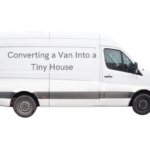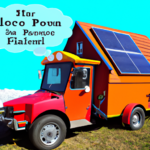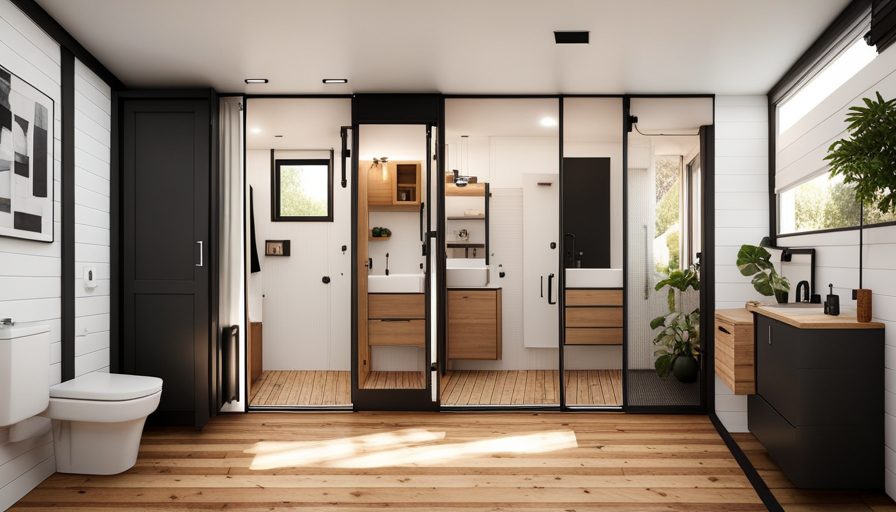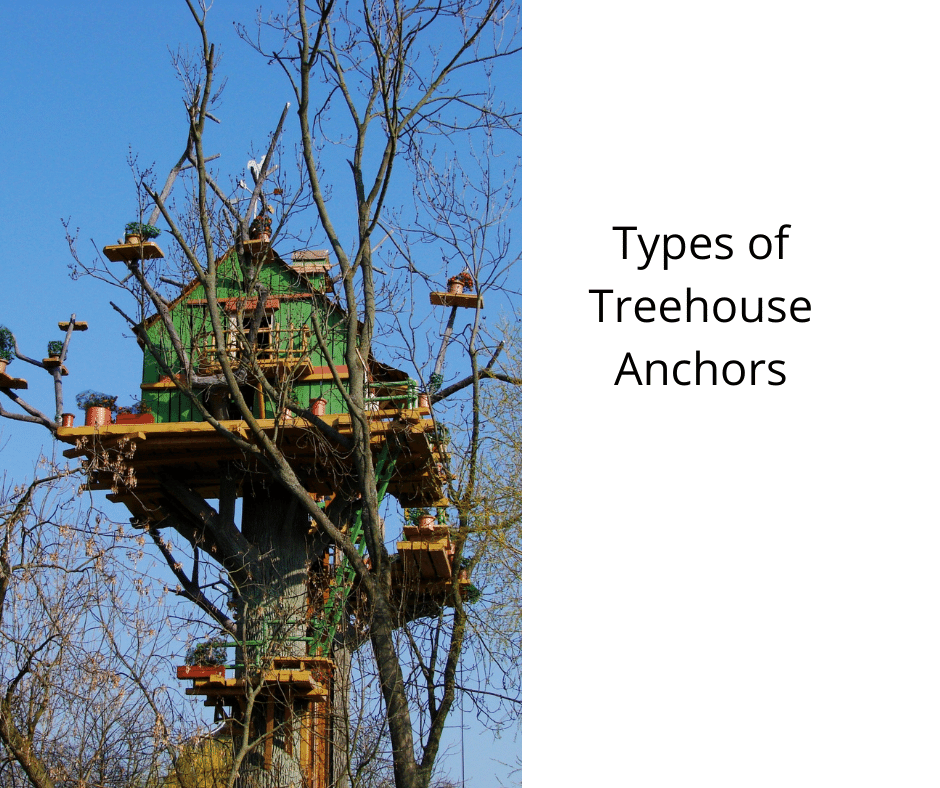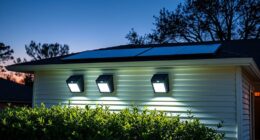As the trend of tiny homes and van conversions continues to grow, shuttle buses are becoming a popular option for those seeking a mobile living space. One impressive example is a 2016 Ford E50 shuttle bus that has been transformed into a cozy and stylish home on wheels. The bus was originally bought for $12,500, with an additional $8,000 invested in the conversion work. This 25-foot shuttle bus comes with amenities such as a deck, solar panels, and a rooftop storage box.
The interior of the shuttle bus is carefully designed with the use of space in mind, featuring an array of clever solutions to make the most out of every inch. The pull-out toilet drawer and hidden shower in a cabinet are just some of the elements that make this shuttle bus conversion stand out. Additionally, it offers a pet-friendly setup with a no-spill water bowl for furry friends. Combined with houseplants and a cat-approved design, this shuttle bus conversion is an inspiration for anyone seeking to create their own mobile living space.
In this article, we will take a closer look at the features of the vehicle, the interior design and setup, as well as provide tips for living on the road.
Key Takeaways
- The shuttle bus conversion home is a functional and stylish way to transform an ordinary vehicle into a cozy and inviting home on wheels.
- Living on the road requires prioritizing organization, flexibility, and self-sufficiency, as well as finding reliable parking spots and managing finances.
- The interior of the shuttle bus conversion home is designed with space-saving features, creative storage solutions, and a cozy atmosphere for a comfortable living experience.
- Joining online communities or forums for fellow nomads can provide valuable insights and recommendations for safe and legal parking spots, budgeting, and other aspects of living on the road.
Vehicle Features
The 2016 Ford E50 shuttle bus, measuring 25 feet long, offers an array of features that make it a perfect fit for a cozy home on wheels.
The solar panels installed on the roof provide ample power for the electrical needs of the inhabitants.
Additionally, the roof storage box offers additional storage options, which is especially important for a small space like a shuttle bus conversion.
The interior of the shuttle bus boasts a pull-out toilet drawer and hidden shower in a cabinet, providing convenience and functionality for its inhabitants.
The 62-inch interior height is also noteworthy, as it allows for comfortable movement within the space.
Overall, the 2016 Ford E50 shuttle bus offers a promising foundation for a well-equipped and comfortable living space.
Interior Design and Setup
One aspect of the interior design and setup of this mobile dwelling is the use of space-saving features, such as a pull-out toilet drawer and hidden shower cabinet, to maximize the limited square footage.
The interior of the shuttle bus conversion home exudes a cozy and inviting atmosphere, thanks in part to the use of houseplants that add natural beauty and a touch of tranquility to the space.
The creative use of storage solutions is also evident throughout the interior design, with storage compartments and drawers integrated into every nook and cranny of the shuttle bus.
The interior of the shuttle bus conversion home is designed to be functional and stylish, with a focus on comfort and convenience.
The living area features a comfortable sofa that doubles as a bed, along with a small dining table and chairs.
The kitchen is equipped with a big stand-up style fridge with a freezer section, a sink, and a two-burner stove, offering all the amenities of a traditional home.
The bathroom, with its pull-out toilet drawer and hidden shower cabinet, is a testament to the creativity and ingenuity of the builders who managed to fit all the necessary features into a small space without sacrificing style or comfort.
Overall, the shuttle bus conversion home is a testament to the power of creative design and the ability to transform an ordinary vehicle into a cozy and inviting home on wheels.
Tips for Living on the Road
To successfully adapt to a nomadic lifestyle, it is essential for individuals to prioritize organization, flexibility, and self-sufficiency while on the road. This means having a solid plan for budgeting and managing finances, as well as being able to adapt to unexpected changes in travel plans.
One helpful budgeting strategy for those living on the road is to keep track of all expenses and create a monthly budget. This can help individuals stay on track and avoid overspending. Additionally, it is important to find ways to save money on things like food and gas, such as cooking meals in the shuttle bus and taking advantage of discount programs for fuel.
Finding reliable parking spots is another crucial aspect of living on the road. While some individuals may choose to stay at RV parks or campgrounds, others may prefer to boondock or park overnight in rest areas or on public lands. It is important to research and plan ahead to find safe and legal parking spots, and to be respectful of local laws and regulations.
Additionally, it can be helpful to join online communities or forums for fellow nomads, as they may have valuable insights and recommendations for parking and other travel tips.
By prioritizing organization, flexibility, and self-sufficiency, individuals can successfully adapt to a nomadic lifestyle and enjoy the freedom and adventure of life on the road.
Frequently Asked Questions
How many miles per gallon does the shuttle bus get?
The fuel efficiency of the 2016 Ford E50 shuttle bus, without considering any modifications or conversions, is estimated to be around 12-15 miles per gallon. This figure may vary depending on driving conditions, the weight of the vehicle, and maintenance.
However, it is important to note that the gas mileage of the shuttle bus may have been affected by the conversion process and the added features such as the solar panels and storage box on the roof.
As such, the actual fuel efficiency of the adorable shuttle bus conversion home may differ from the original estimated gas mileage.
How long did the entire conversion process take?
Managing the timeline of a conversion project requires great skill, like conducting a symphony orchestra. The creative design process is both exciting and challenging, and it is essential to manage the time effectively.
In the case of this shuttle bus conversion, the timeline management and creative design process took approximately six months. The project involved significant structural changes, including installing solar panels, building a deck, and adding a storage box on the roof. The interior design was also carefully planned to maximize space, with a pull-out toilet drawer and a hidden shower in a cabinet. The cozy feel of the interior was achieved through the use of houseplants and cat-approved setups.
The lessons learned from the previous experience of converting a 40-foot skoolie were applied to this project, resulting in a more efficient and effective conversion. The big stand-up style fridge with a freezer section was an essential addition, and the use of a no-spill water bowl made it pet-friendly. Moving the shuttle bus was made easier by unplugging USBs and tipping it forward to store water securely.
The full conversion tour provides more tips and insights into the timeline management and creative design process.
What was the biggest challenge during the conversion process?
During the conversion process, challenges were faced in making design decisions that would maximize the limited space of the shuttle bus.
The biggest challenge was finding the right balance between functionality and comfort, especially with a limited interior height of only 62 inches.
This required careful planning and consideration of every aspect of the layout, such as the placement of furniture and storage, as well as the choice of appliances that could fit within the space.
Additionally, the need to accommodate a pet-friendly environment added another layer of complexity to the design decisions.
Despite these challenges, the end result was a cozy and functional home on wheels, with a variety of clever features that made the most of the available space.
How often does the owner have to refill the water tanks?
When it comes to water tanks, the frequency of refills and maintenance requirements can vary depending on the type of system installed. Without knowing the specific setup of the owner’s shuttle bus conversion, it is difficult to determine an exact refill schedule.
However, typical RV water tanks can hold between 20-100 gallons of water, and the frequency of refills will depend on the water usage habits of the owner. Factors such as the number of occupants, frequency of showers, and frequency of dishwashing will all play a role in determining how often the tanks need to be refilled.
As for maintenance, regular cleaning and sanitizing of the tanks is crucial to prevent the growth of bacteria and maintain water quality. It is recommended to clean the tanks every 3-6 months or as needed based on usage.
Have there been any unexpected maintenance issues with the vehicle since the conversion?
Regarding maintenance expenses and troubleshooting techniques, there have been no specific issues mentioned by the owner of the 2016 Ford E50 shuttle bus since its conversion into a cozy home on wheels.
However, it is important to note that owning a converted vehicle, such as a shuttle bus, may come with unexpected maintenance expenses and the need for troubleshooting techniques.
Regular maintenance is essential to keep the vehicle running smoothly and to prevent any major issues from arising.
It is also recommended to have a basic understanding of troubleshooting techniques for any minor issues that may occur while on the road.
Overall, while the owner of this particular shuttle bus conversion has not mentioned any unexpected maintenance issues, it is important for anyone considering a similar conversion to be prepared for potential expenses and to have some knowledge of troubleshooting techniques.
I’m Theodore, and I love tiny houses. In fact, I’m the author of Tiny House 43, a book about tiny houses that are also tree houses. I think they’re magical places where imaginations can run wild and adventures are just waiting to happen.
While tree houses are often associated with childhood, they can be the perfect adult retreat. They offer a cozy space to relax and unwind, surrounded by nature. And since they’re typically built on stilts or raised platforms, they offer stunning views that traditional homes simply can’t match.
If you’re looking for a unique and romantic getaway, a tree house tiny house might just be the perfect option.


